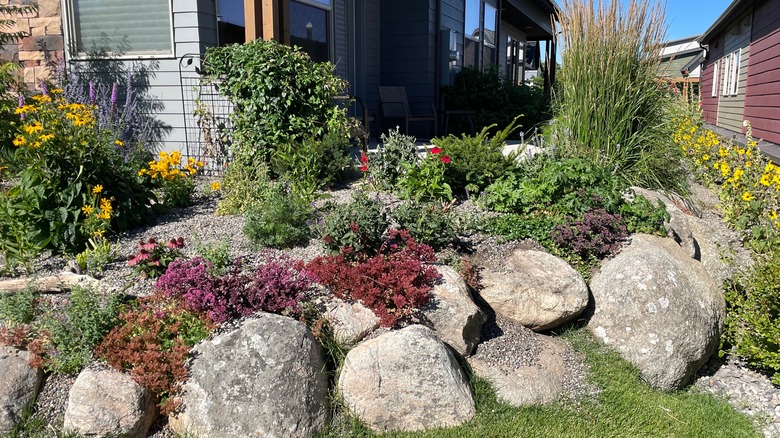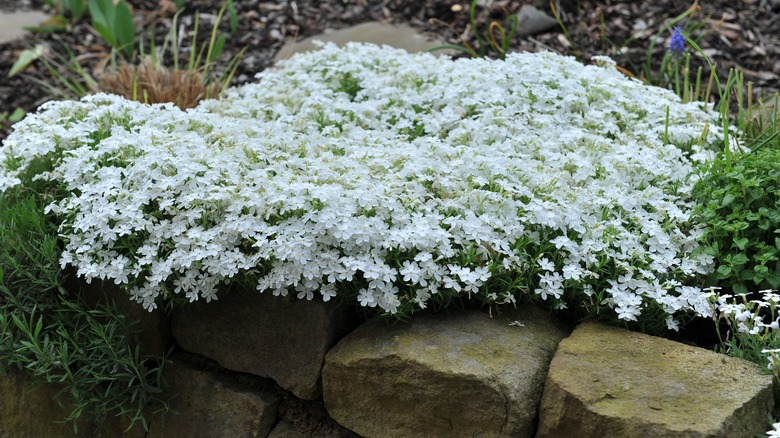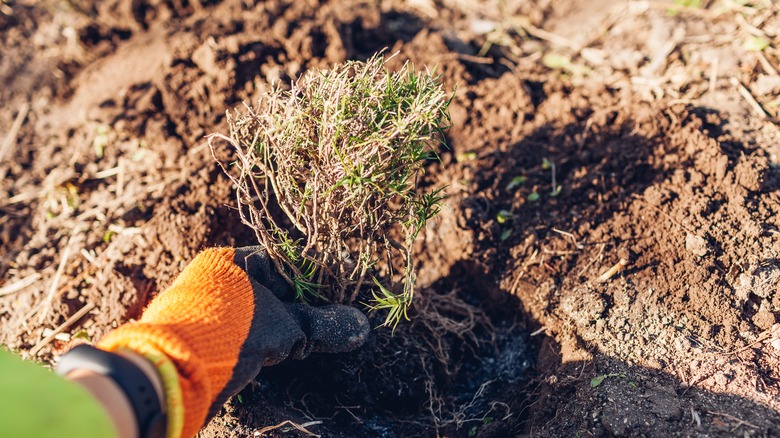The Lush Flowering Plant That Happily Spills Over Stone Edging Or Borders
Getting a lush and natural look on your landscaping borders might seem impossible sometimes, but it's all a matter of finding the right plant — and having the patience to let it grow. Ideally, you want greenery that forms a mat, hiding pavers, metal strips, and any other unnatural edging. All the better if it flowers in the spring or summer, adding some interest to those often dull borders. Happily, two hardy natives, both coincidentally called creeping phlox, have you covered.
Phlox subulata is native to the eastern and central U.S. and Canada and goes by a bunch of names — creeping phlox, moss phlox, mountain phlox, moss pink (or moss-pink), flowering moss, ground pink, mountain pink, rock phlox, and thrift. This plant thrives in U.S. hardiness zones 3 to 9. Its flowers boast notched petals and a wide range of hues (red, purple, blue, pink, white, and even bi-colored and striped), and it grows to a maximum height of 6 inches.
Phlox stolonifera, on the other hand, goes only by creeping phlox or star rock phlox. Its original home is the Appalachian Mountains, meaning it thrives best in zones 5 to 8. The plant is a little taller, reaching an impressive height of 10 inches in optimal conditions. Check the flowers to tell it from its cousin: Their petals are notch-free and colors are limited to white through purple. Phlox stolonifera also blooms a little later, from July through September.
Where to plant creeping phlox to take best advantage of its trailing nature
What makes both species of creeping phlox perfect for rockeries, borders, erosion control, and even container gardens is their low, spreading growth habit, preference for well-drained soils, drought resistance, and love of sunny locations. Use them to fill in space between pavers, cover the harsh walls of shrub-planted pots and hanging baskets, curtain down rock retaining walls, and highlight garden pathways. Since they're endemic to America, the creeping phloxes also work well in woodland clearings, native plant gardens, and naturalized areas alike. Because of all this, plus the fact it tolerates foot traffic, this plant makes a great turfgrass alternative in lawns and median strips too. Have a steeply inclined yard that's difficult to maintain? Use creeping phlox as a weed-suppressant and never mow again!
If you're cultivating a vibrant spring backyard, you should be planting creeping phlox for a garden full of color — especially Phlox subulata. The early spring bloomer has cultivars in so many hues, each forming dense blankets of flowers that stand out against more subdued shrubbery. The foliage is technically evergreen (or semi-evergreen in the case of Phlox stolonifera) but can die off a little in winter so plant it with evergreens or plants that flower in other seasons if you're worried about unsightly brown patches. With such bountiful blooms, it's no surprise that both species attract pollinating insects and hummingbirds. They're also hosts for caterpillars and, major bonus, are mostly ignored by deer and rabbits.
Buy your creeping phlox plants and get ground-covering
Both species of creeping phlox can be found online and at garden centers or big box stores. Phlox plots must be separated to remain healthy and blooming so you could also offer to help a friend or neighbor divide their patch and take away some plants with roots for free. In fact, passing along creeping phlox plants in this manner is a long-standing tradition in American gardening. Once you have your plugs in hand, focus on how to successfully grow a creeping phlox plant. Unlike many ground covers, phloxes do better when planted as singletons rather than in groups (even if you purchased them in packs). They spread outwards from the central plant in all directions, filling in the gap between two pavers or adorning a once-barren rock crevice with a 20-inch wide carpet of greenery and spring blooms at a medium-fast pace.
If you want to cover a large area — say, a hard-to-plant slope — simply space multiple creeping phlox plants at least two feet apart. Then, dig a hole, add a handful of balanced garden fertilizer or compost, pop in a plant, and mulch liberally. Luckily, these plants are generally pretty low maintenance once they're firmly set in place. They rarely get sick either; just watch out for signs of dieback since creeping phlox occasionally gets attacked by fungal diseases. Cut these perennial plants back after they flower — around mid-August for Phlox subulata and later for Phlox stolonifera — to boost blooms and foliage for the coming season.



